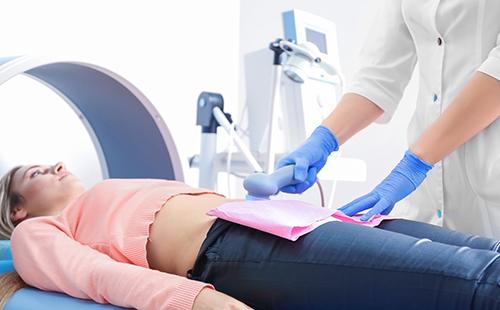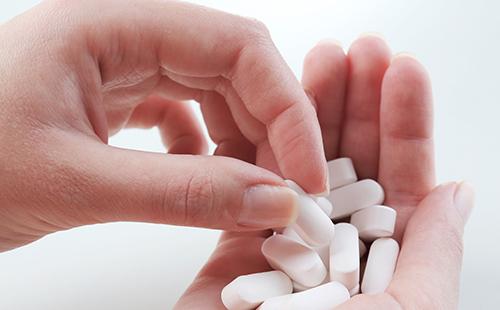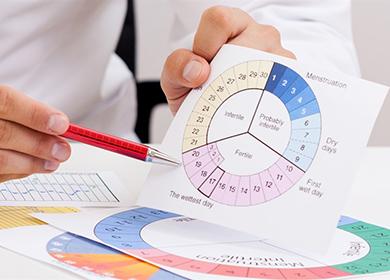The content of the article
For some women, the period of the formation of menstruation in adolescence does not go into a full cycle. If this is not reported to the doctor, then the problem remains without attention and every year the condition only worsens. Menstruation can become less frequent or vice versa, bleeding between them is more pronounced. What needs to be done in this situation? What threatens an irregular cycle?
Regulation of the female genital glands
Female genitals are closely interconnected with hormone-active brain structures - the hypothalamus and pituitary gland. The ovaries themselves affect the uterus and regulate the uterine cycle. If a breakdown occurs in one of the links, this affects the functioning of the entire system.
The ovarian cycle proceeds in two phases, in accordance with which changes in the uterus occur.
- Folliculin. During this period of time, the dominant follicle grows and the egg ripens. Gradually, this leads to ovulation: the follicle membrane bursts, the egg goes out.
- Luteal. In place of the bursting follicle, a temporary endocrine organ is formed - the corpus luteum.
The eggs are laid during the period of intrauterine development, and by the time of the birth of the girl she has about 2 million primordial follicles. These are formations containing one egg each, which is in an immature state. During menstruation, from three to 30 such follicles under the influence of follicle-stimulating hormone begin to mature - they become primary.
Further maturation makes the primary follicle secondary. In it, the egg is not only surrounded by a shiny membrane, but also contains follicular fluid.
By the eighth day of the cycle, one of the follicles begins to stand out - the dominant. It grows to 20 mm, the remaining follicles regress. At the time of ovulation, a rupture of the membrane occurs, the egg enters the abdominal cavity. Capillaries quickly grow in place of a ruptured follicle. Under the influence of luteinizing hormone (LH), a corpus luteum forms.
The life of the corpus luteum does not depend on the duration of the cycle. If fertilization has not occurred, then after 14 days it regresses. If pregnancy has occurred, then the corpus luteum increases in size and functions until the formation of the placenta.
Follicle maturation, ovulation, the work of the corpus luteum - all these processes are connected by fluctuations in the level of sex hormones:
- estrogen;
- progesterone;
- androgen.
While the follicle grows, its cells produce all fractions of hormones, but estrogen predominates. From the moment of ovulation to menstruation, the level of progesterone, which is produced by the corpus luteum, rises. The concentration of androgens, which are secreted by theca cells of the ovaries, does not change throughout the cycle.
Sex hormones affect target organs:
- the uterus;
- mammary gland;
- bone tissue;
- endothelium and vascular smooth muscle;
- skin
- heart muscle.
Cyclical secretion of the main hormones leads to characteristic changes in the endometrium. In the first phase, under the influence of estrogen, an increase in its thickness occurs - proliferation. In the second phase - secretion - glycogen is actively accumulating in it, the number of vessels increases, the glands become more convoluted and produce their secret.
The cycle ends with the beginning of menstruation - rejection of the functional layer of the endometrium, but only if conception has not occurred.
Ovarian dysfunction: what it is and what diseases it signals
Ovarian diffusion in women, what does it mean and is it treated? The characteristics of a normal menstrual cycle are as follows.
- Duration. On average, it lasts 28 days. But its extension to 35 days or shortening to 21 days is considered normal.
- Bleeding. Menstruation itself takes about 4 days. The period from 3 to 6 days also applies to the norm.
- condition. The general condition during menstruation should not suffer. A woman may feel a little pain in the first days of menstruation, engorgement of the mammary glands several days before menstruation.
But under the influence of various factors, the characteristics of the normal cycle change. The causes of disorders and dysfunction of the ovaries can be as follows.
- Inflammatory diseases. Infection in the ovaries and fallopian tubes (salpingitis, oophoritis or a combination thereof), uterine damage (endometritis), necks (cervicitis) violate the hormonal background. Foci of chronic inflammation lead to local immune responses, and the inflammatory response leads to cell damage and impaired hormone secretion.
- Non-inflammatory diseases. Myoma, endometriosis are a consequence of relative hyperestrogenism, but they themselves are involved in maintaining the wrong ratio of hormones.
- Endocrine diseases. Obesity and diabetes are the main causes of reproductive dysfunction. Adipose tissue has hormonal activity. In it, androgens form several biochemical reactions to form estrogens, which will already be excessive. This disrupts the normal menstrual cycle. Thyroid pathologies are also dangerous. This endocrine organ has a pronounced effect on the reproductive system.
- Abortion. Spontaneous abortion or medical abortion equally affects the work of the ovaries. Especially dangerous is the first termination of pregnancy. After the embryo is born, the hormonal background changes in such a way as to ensure the preservation of pregnancy. But a sudden interruption confuses the body. How then the ovaries will function is difficult to predict.
- Nutrition. Strict diets with a restriction of protein, fat, lead to exhaustion. The extreme degree of this behavior is anorexia. Due to a lack of nutrients, a persistent violation of the functioning of the genitals develops, menstruation disappears. Getting pregnant with persistent ovarian dysfunction is not possible.
- Stress and Exercise. The irrational mode of work and rest, nerve stresses affect the brain, and it affects the secretion of LH and FSH. The additional effect of stress hormones affects the functioning of the ovaries.
- External factors. We must not forget about the negative effects of radiation, toxic substances, certain drugs, excessive insolation.
Menopausal dysfunction of the ovaries is combined with age-related changes. The regular aging of the body, inhibition of estrogen production affects the rest of the genital organs. This condition is often complicated by existing myoma or endometriosis. Therefore, bleeding in the period before the onset menopause more pronounced.
How to recognize pathology
Symptoms of ovarian dysfunction are expressed in changes in the menstrual cycle.You can suspect a malfunction of the ovaries in the following cases.
- Cycle failure. Menstruation becomes irregular, their duration changes. Often there are delays in menstruation, after which severe bleeding begins. The interval between menstruation can also be shortened. Sometimes blood flow occurs at such irregular intervals that it is difficult to distinguish menstruation from uterine bleeding. This condition is called dyscirculatory uterine bleeding (DMC). It can appear in women of reproductive age, during menopause, and even in adolescents.
- Premenstrual syndrome. Unpleasant signs of ovarian dysfunction in women appear almost immediately after ovulation. The engorgement of the mammary glands, swelling, mood changes, a tendency to depression, headaches torment. Menstruation itself can also be accompanied by unpleasant symptoms.
- Pain syndrome. Pain in the lower abdomen of a pulling, cramping nature can appear before menstruation, during it and during ovulation.
- Amenorrhea. The extreme manifestation of a cycle failure is the absence of menstruation for six months or more.
- Infertility. Impaired hormone secretion leads to changes in the endometrium. It becomes unsuitable for implantation of an embryo. Often in this condition, the menstrual cycle becomes anovulatory - the egg does not mature. As a result - the impossibility of pregnancy.

Features and significance of diagnosis
Screening for ovarian dysfunction includes a large list of tests and instrumental studies. But the choice of a specific method depends on the clinical situation. Diagnostic methods and the purpose of their appointment are described in the table.
Table - Diagnostic techniques for ovarian dysfunction
| Type of study | Indicators | What reflects |
|---|---|---|
| General blood analysis | - Red blood cells; - white blood cells; platelets; - hemoglobin; - blood formula; - ESR | - General health status; - the presence of inflammatory processes; - anemia |
| General urine analysis | - Color, specific gravity; - protein; - white blood cells; - salt; - epithelium and mucus | - The work of the kidneys; - the state of the bladder (inflammatory processes can be combined with those in the genitals) |
| Vaginal swab | - The prevailing flora; - the presence of opportunistic microorganisms; - pathogenic flora (gonococci, trichomonads); - the number of leukocytes; - candida and their mycelium; - slime; - key cells | - The presence of inflammation; - vaginal dysbiosis; - candidiasis; - specific inflammation (gonorrhea, trichomoniasis) |
| Pap test | - Atypical cells; - white blood cells; - bacteria | - Background and precancerous diseases; - tumors of the reproductive system; Papillomavirus infection |
| Bakposev | Determination of the pathogen of inflammation | - The specific type of infection; - sensitivity to antibiotics |
| PCR diagnostics | DNA of a specific pathogen | - Papillomavirus; - chlamydia; - mycoplasmas; - ureaplasmas; - trichomonads |
| Blood hormones | - estrogens; - progesterone; - prolactin; - androgens; - FSH; - LH; - corticotropin; - thyroid hormones (TSH, T3, T4) | Thyroid disease (Tests performed on day 5 after menstruation) |
| Pelvic ultrasound | Ovarian size; - the presence and condition of follicles; - yellow body; - cysts; - the size and condition of the uterus; - thickness of the endometrium; - pathological foci; - condition of the fallopian tubes; - the presence of free fluid in the stomach | - Pathological changes in the reproductive organs; - foci of inflammation; - myoma; - endometrioid cysts; - functioning of the ovaries (by the presence of follicles, corpus luteum) |
| Thyroid ultrasound | - The size; - pathological inclusions; - blood flow | - Functional condition; - pathological changes |
| MRI and CT of the brain | - The state of the hypothalamus and pituitary gland; - dimensions of the Turkish saddle | - Pathological changes, tumors; - atrophic changes, calcifications |
| Diagnostic curettage | - The structure of the endometrium; - types of cells and their condition; - pathological inclusions | Pre-tumor processes, hyperplasia |
| Biopsy hysteroscopy | - The condition of the uterus; - foci of endometriosis, polyps | - Adenomyosis; - endometrial polyps; - myomatous nodes with submucous growth |
Therapeutic approaches
Treatment of ovarian dysfunction begins with the elimination of the cause of the disease, and depends on the results of the examination. Therefore, the ICD-10 code will reflect the underlying disease. It is necessary to normalize the way of life, abandon bad habits, establish proper nutrition and rest. Women in hazardous work may have to change jobs.
- Infections. The treatment regimen depends on the specific pathogen. Be sure to prescribe antibiotics, vitamins. During the recovery period, physiotherapy is possible.
- Hormonal disorders. Treatment depends on the prevalence or lack of a particular hormone. In case of hyperprolactinemia, “Cabergoline”, “Bromocriptine” is used, with a lack of progesterone, its injections or oral administration of “Dufaston”, “Utrozhestan” preparations are used from the 16th to 25th day of the cycle. In some cases, the appointment of combined oral contraceptives is sufficient.
- Myoma. A course of hormonal treatment with drugs that block ovarian function can be used. But this is a temporary measure. In most cases, you have to resort to surgical treatment. At a young age, this is embolization of the uterine arteries or FUS-ablation to preserve the organ, in women in the premenopausal period - removal of the uterus. But at the same time, the right ovary or left is maintained to prevent castration syndrome.
- Endometriosis. Used treatment with hormones that cause temporary medical castration. Surgical removal of foci is also performed.

Folk methods
Many people try to cure ovarian dysfunction at home on their own. But such experiments with their health can lead to serious consequences: ovarian dysfunction leads to infertility, and with severe uterine bleeding, attempts to stop it and delaying it with medical help can lead to severe anemia when a blood transfusion is needed, and to stop the bleeding, the removal of reproductive organs.
Therefore, you should not rely on the reviews of friends or acquaintances, but first go through a quality diagnosis and establish the cause of the dysfunction. Folk remedies can be used as auxiliary, which will complement the main treatment or help during the recovery period.
Traditional medicine suggests using uterus and funds from it for the treatment of any manifestations of dysfunction, uterine fibroids, endometriosis, adnexitis. This plant is prepared in the form of a decoction, alcohol or oil tincture and used inside. Often it is combined with other herbs, for example, red brusha shepherd’s bag.
Ovarian dysfunction of the reproductive period leads to infertility. This is a hard blow for a woman who wants to have children. Therefore, you should not start the treatment of inflammatory diseases, interrupt your first pregnancy, enter into random relationships. Remember that the health of each person 50% depends on himself, and only then on medicine and the environment.
Reviews
I had ovarian dysfunction. There were no monthly periods of 6-8 months. Treated with hormones (microfollin and pregnin). Then a tumor grew on the left ovary and it was removed along with the tube. After the operation, menstruation began to go more often, once every 2 months. The ovary increased, but hormones were not prescribed. Generally did not know what to do with me. Pregnancy said it wouldn’t be exact. I cried my way and reconciled. And exactly 5 months later B. came. I did not even believe my eyes when I saw 2 strips! But unfortunately she froze at 10 weeks in spite of the fact that she took Utrozhestan 2 * 2 times for the entire period. The reason most likely is hormonal imbalance. Now the TTT cycle is regular (the south and drops of craft and the uterus have helped). I carefully plan the next B., will be examined, but the doctor does not give any forecasts so far. . Must be treated with a good doctor to B. Causes of dysfunction: hormonal imbalance, chronic inflammation, stress, malnutrition.
ALLY http://www.kid.ru/forummam3/t15644.html
Hello! I also recently stumbled on articles about the pine forest and immediately bought it. I think it definitely won’t be worse. My friend and I have long wanted kids, we already have one child. and so we drank for a month and the girlfriend already had a delay and the test showed two stripes. think think it helps or not
Tiny http://www.woman.ru/health/woman-health/thread/3839987/2/
I had a dysfunction. The diagnosis was made at 19 years old. It turned out that due to an excess of male hormones, I have hyperandrogenism. I drank OK as prescribed by the doctor, and everything worked out. Now I am 25. My son is three years old.
Belka and Strelka, http://www.woman.ru/health/woman-health/thread/4329997/
They told me the same thing! And prescribed to drink OK. But I am categorically against it, I don’t know why, but I don’t want to drink them and that's it. I drank OK for 2.5 years, then quit and for six months there were no periods. The doctor said that we should drink OK again to restore the month. and get pregnant. But something inside me resisted that. And imagine I drank Duphaston 5 days, and the cycle has recovered! At least one small step in the right direction, now we have to wait for B. And every 5th patient speaks about ovarian dysfunction. And OK really “euthanizes” the ovaries, they generally stop working, because OK for them. The choice is yours.
Tatjanka, http://eka-mama.ru/forum/part277/topic81561/
You don’t have to be sad, but you should not wait for the weather by the sea either. It is necessary to identify the cause of the dysfunction. I also had it. Monthly from the age of 14 could not come for six months. At first I drank OK. But they do not solve the problem. When she wanted a child, she first tried with her husband for a year, did tests for ovulation, but she could never catch it. Then a gynecologist-endocrinologist. A cycle of 2-3 stimulation of ovulation was done with it in different ways. First, some simple pills, then clostilbegit (sold at the pharmacy only by appointment, at least they sold me that way). All these cycles were done by ultrasound on a certain day. Understood that follicles do not ripen. Then expensive injections in the stomach, which stimulate the growth of follicles. And on the ultrasound it was determined that the ovaries are simply covered with a dense film and the follicles cannot normally grow and exit, i.e.There is no ovulation, and the result is no menstruation. As a result, laparoscopy was done. And now my son is 2 years old, now pregnant with the second, pregnancy came right the first time, when they stopped protecting themselves. Good luck and a good doctor!
Ekaterina Khersonova (Balachina),
https://deti.mail.ru/forum/v_ozhidanii_chuda/planirovanie_beremennosti/disfunkcija_jaichnikov_by_bodya_79_mail_ru/

